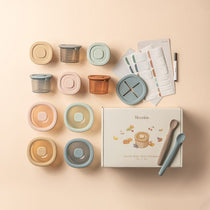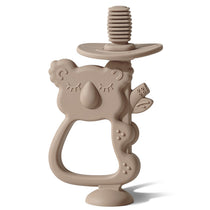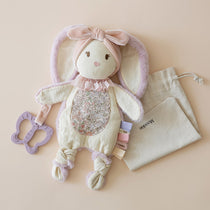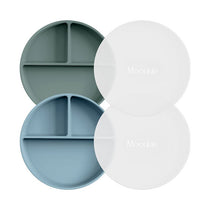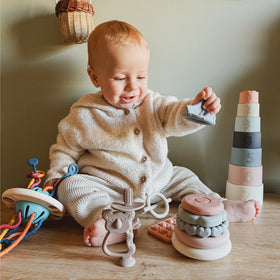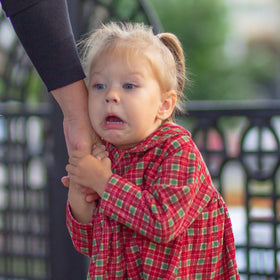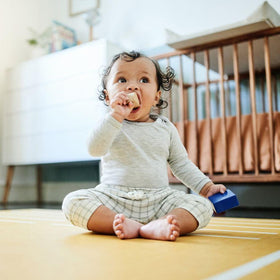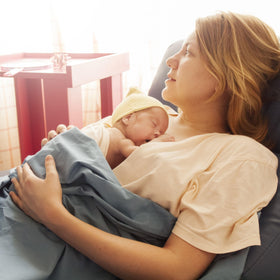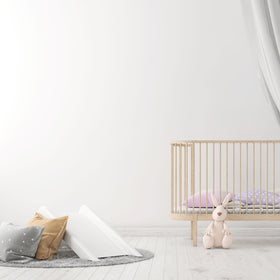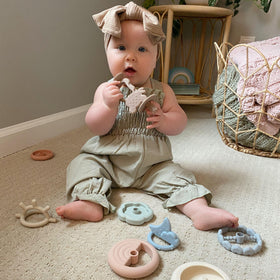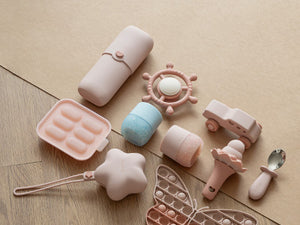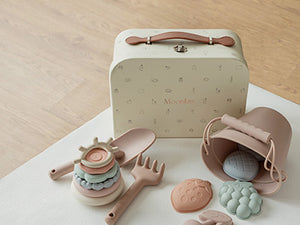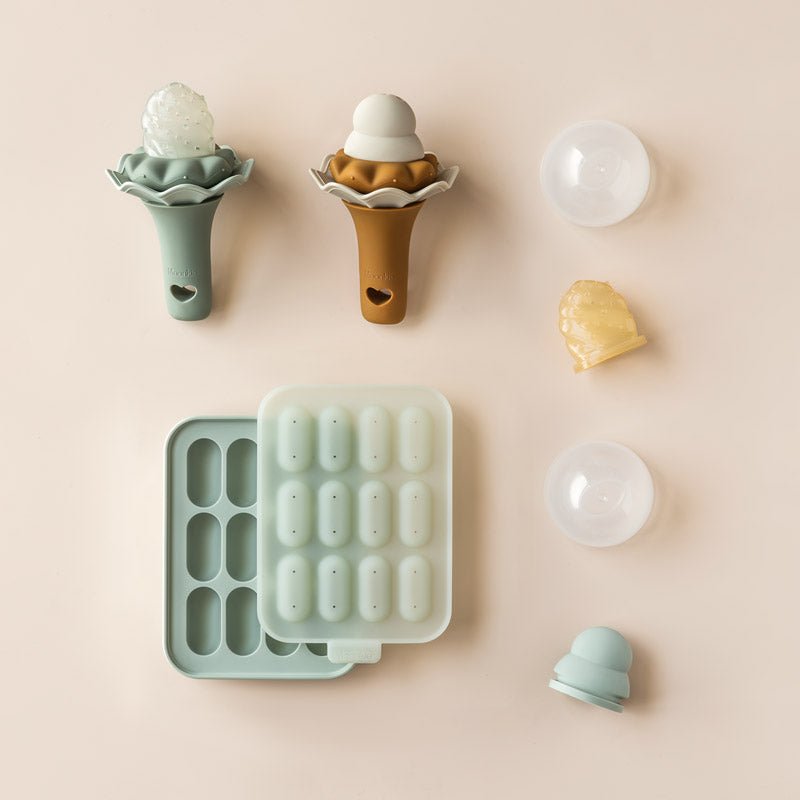
Thanks to years of being pummeled by "go green" campaigns in school, commercials, presidential debates, and billboards, you know going green is something you would like to do. But how can you create a sustainable home for your family on a tight budget with little free time?
Most advice revolves around buying eco-friendly cleaning products, reducing waste, and investing in sustainable baby and house products. Going green means changing your lifestyle to more sustainable habits. Not everything will be zero waste with a baby around, but you can take sustainable steps.
Now, there's a ridiculous amount of content on the internet for this topic, so this article will also cover more specific questions I asked as a new mom and struggled to find answers for.
The Big Sustainability Problem
If you think going green with a baby around will be a daunting task, you are not entirely wrong. According to the Environmental Protection Agency's 2018 waste report, the average American family produces 4.9 pounds of waste per person daily (source).
That was years ago--before COVID. Until the EPA releases an updated report, we can only speculate. But you can think about your own family and how many diapers you throw away daily, multiply that by the 3,745,361 U.S. babies born in 2023, and you have a rough estimate of how many diapers go into the trash each day (source).
300,000 disposable diapers are sent to landfills, get incinerated, or end up outside every minute in the U.S. alone (source). That's a significant number and a measurable amount for you to do something about.
Invest in Sustainable Baby Products
Thankfully, we live in a time where access to sustainable baby products exists, albeit at a price. If you think about the cost upfront in terms of cost per use, however, you will find that many sustainable baby products actually give you more bang for your buck over the long run, especially if you have multiple kids.
Sustainable baby products include reusable diapers, cloth wipes, glass bottles, natural rubber pacifiers, wooden toys, and long-lasting, multi-purpose items like Moonkie's high-quality food-grade silicone toys and feeding sets.
At Moonkie, we are concerned about climate change and the wastefulness of plastic baby products. So, we have set out to create a line of sturdy, well-designed baby toys and products that grow with your child.
If you want to read a comprehensive guide on sustainable baby product essentials, check it out here: The Ultimate Guide to Reusable Essential Baby Products. In the spirit of not repeating myself, let's move on!
Use Eco-friendly Cleaning Products
You've got to clean, and the sprays, soap, and scented cleaning products you use matter for the environment and your family's health. The products we use daily are chock-full of harmful chemicals--even the ones that are "rated safe."
But what is the alternative? "Eco-friendly" cleaning products are so expensive! Though you are not likely to get down to dollar store prices, you can leverage bulk natural soap, detergent, and cleaning product purchases every few months or go in on a bulk purchase with a friend or two.
Still, I had quite a few questions in this department as a new mom. Here are three of those questions answered for your benefit.
Which "Natural Soaps" Should I Buy for Sustainability?
You can likely find a sustainability-minded soapmaker near you. Just ask about their soap-making process and the ingredients they use. Ask about bulk discounts if you like the quality and your skin isn't irritated!
Common soap ingredients that are NOT eco-friendly or good for your health are:
Ingredient |
Problems |
artificial, perfume, or natural fragrance |
often petroleum-based and may cause dermatitis, allergies, hormone disruption, or respiratory issues |
artificial coloring |
heavy metals absorbable through the skin |
sodium lauryl sulfate |
a common skin irritant used for foaming |
triclosan and triclocarban |
used for antibacterial properties, but they are probable carcinogens and impact the eyes, lungs, ears, thyroid, endocrine system, and reproductive system |
parabens |
soap preservative that is possibly carcinogenic and can cause skin irritation, fertility issues, or hormone imbalance |
ethanolamines |
DEA, MEA, and TEA are hormone disruptors |
dioxane |
a chlorinated solvent stabilizer that's bad for organs |
formaldehyde |
carcinogen, skin irritant, and toxin |
Once you start actually looking at soap ingredients, you may be horrified at how many chemicals you've been using that are awful for your family's health and the environment.
But thankfully, many people have picked up on the same issue and started businesses that make more responsible ingredient choices. Many small businesses make castile soap or coconut- or palm oil-based soap with essential oils.
The difference between soap recipes comes down to what natural resources are available to the soapmaker at reasonable prices. Coconut oil is a popular base for homemade soap because it is cheap in comparison to other oils.
An olive oil-based soap (castile) is an excellent option for those with super dry skin or allergies to coconut and palm oil. If environmental sustainability is a priority for you, ensure that it is also a priority for your soapmaker and ask about how their ingredients are harvested.
Are There Sustainable Laundry Detergents?
Yes! You can find many home laundry detergent recipes online. However, not all are safe, effective, sustainable, or wallet-friendly. Ensure you look into how each ingredient is sourced before going all in on a recipe.
For example, a typical homemade laundry soap detergent ingredient your grandma may have used is borax. Borax is a natural substance scraped out of dry lake beds or mined out of open-pit mines. Moreover, it is toxic to young children and builds up in your body through skin contact, your lungs (it's dusty to mix), or your mouth (source).
A super simple homemade laundry detergent uses washing soda and baking soda. Use around a 1/4 cup of white vinegar in the load's rinse cycle for laundry softener and deodorizer.
Dryer sheets are awful for your family's health and the environment! You can invest in three to six wool dryer balls instead and use those for years. Just pop three in the dryer with a load and let it run. If you really want a scent, add three to six drops of essential oil to one of the dryer balls.
How Do I Find Natural Cleaning Products?
You can either research homemade cleaning hacks and recipes online or find a company that creates eco-friendly cleaning products. If you are on a really tight budget, stock up on the homemade cleaning solution essentials.
If you opt to make your own cleaning solutions, you may be surprised at how cheaply you can make them. Watch YouTube videos, collect Pinterest pins, or search for cleaning recipes with natural ingredients online. Most recipes change based on the task, so don't expect an all-in-one spray cleaner.
Here are a few common homemade cleaner ingredients:
white vinegar
lemon essential oil
grapefruit essential oil
orange essential oil
baking soda
washing soda
castile soap
You can buy these ingredients in bulk online to save money over time. If you cannot afford a bulk purchase right now, you can split the cost with interested friends and family or save up for each purchase.
Invest in Sustainable House Products
Sustainable house products are a bit easier to find but often come with a hefty price tag. That's because responsibly harvested natural materials are costly. But, if you truly want to make sustainable product choices, you'll have to make wise money choices.

You won't be able to get around the monetary investment unless you have some time on your hands. For instance, you could learn to make what you need yourself, go thrift shopping, buy when sustainable items are heavily discounted, or create a family home wish list for friends and family to help with.
If you don't have time for another hobby or hate shopping, you can save up for the products you need. You can also settle for having less and shift to a minimalistic lifestyle. Doing so would free up funds for what you really want and declutter your home!
If you are curious about how a minimalist lifestyle could work with kids, read Balancing Minimalism and Young Kids: What Do They Really Need?
Can I Burn Natural Wax Candles Around My Baby?
Some people just love candles for the mood, scent, homeyness, and warm fuzzy feelings. Yet candles are often loaded with nasty ingredients that could harm you, your baby, and any pets you may have. Natural wax candles could be a middle ground, specifically soy wax or beeswax candles.
Beeswax is a natural, renewable wax that burns warmly and has a slightly sweet smell when burned in a candle. It burns cleanly, which is safe for your baby. However, the bee population is struggling a lot, so beeswax candles are expensive.
Soy wax is a slow-burning wax made from fast-growing soybean plants, which makes soy wax a renewable resource. It is also naturally biodegradable and clean-burning, making it safe at home.
Soy wax is not 100% eco-friendly, though. It requires vast fields, harvesting, cleaning, cracking, dehulling, rolling into flakes, oil extraction, and hydrogenation to go from bean to wax (source).
This takes a lot of manhours, machines, soil compaction from industrial farming, and shipping before a chandler uses it to make a candle. If you live in the U.S., your soy candle is likely made from wax grown and processed in the Midwest, which lessens the impact of shipping compared to other regions in the world.
Can I Find Any Products That Are Truly Sustainable and Eco-friendly?
Very few household products will work out to be totally eco-friendly; there is a cost to everything, unfortunately. However, learning the environmental cost of your family's items and daily routines is a step in the right direction.
By taking steps to minimize your environmental impact by buying sustainable products from responsible companies, repairing broken items, mending torn clothes, buying secondhand, and living more simply will help the environment. Thankfully, these steps will help you financially, too!
Reduce Food Waste
Millions of Americans don't have enough to eat, and that number increases every year. But the irony is that an American family also throws away an average of three pounds of edible food every week, which comes out to 168 pounds a year (source).
According to the Food and Drug Administration (FDA), food waste accounts for 24% of all municipal waste (source). That's crazy!
You can markedly reduce your food waste by planning your week's meals in advance, not buying perishable food in bulk, and eating in more than out. Also, try starting a compost bin or getting some chickens (if possible) for kitchen scraps. That way, you are not sending your food scraps to the landfill.
Reduce Water Usage
Americans also waste a lot of water. The EPA states that an average household's leaks (running toilets, leaky faucets, and such) amount to roughly 10,000 gallons of wasted water annually (source).

Moreover, most of us are totally unaware of how much water we actually use on a daily basis. Most of us think we use less than 100 gallons of water a day, but the actual average is closer to 2,000 gallons (source).
That figure includes percentages of water used to produce the things we utilize daily, like our jeans, shirts, and smartphones. Additionally, it includes percentages of the water it takes to raise the food we eat, like meat, vegetables, and fruit. Thinking like this, we all may be shocked at our water usage!
Of course, you can look at your water bill to determine how much water you use in your house every day and take some steps to minimize it. Perhaps that means wearing your jeans more than once, washing breakfast dishes by hand rather than by dishwasher, and using pasta water for other things.
In a Nutshell
Once you start creating a sustainable home, you'll find more and more rabbit holes to go down and hurdles to jump through. Your family will use resources, and unless you live off-grid with a zero-waste mentality, you will probably leave a footprint.
However, you can safeguard your family's health and shrink your impact on the environment by educating yourself on what is in the products you use and how they are made, and invest in quality products that will serve your family for years. So, where are you going to start?


